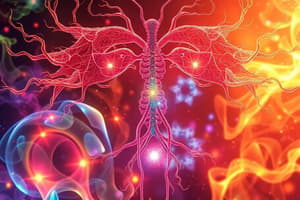Podcast
Questions and Answers
ما هي أداة AnyScanner المستخدمة في الغالب؟
ما هي أداة AnyScanner المستخدمة في الغالب؟
- برنامج معالجة الصور
- ماسح ضوئي للوثائق (correct)
- محلل النصوص
- أداة تطوير البرمجيات
AnyScanner هي أداة تستخدم لتحليل البيانات الكبيرة فقط.
AnyScanner هي أداة تستخدم لتحليل البيانات الكبيرة فقط.
False (B)
ما هي الوظيفة الرئيسية لـ AnyScanner؟
ما هي الوظيفة الرئيسية لـ AnyScanner؟
مسح الوثائق
يمكن استخدام AnyScanner ل _____ الوثائق.
يمكن استخدام AnyScanner ل _____ الوثائق.
طابق بين الأدوات والوظائف:
طابق بين الأدوات والوظائف:
Flashcards
AnyScanner
AnyScanner
أداة مسح ضوئية
أغراض AnyScanner
أغراض AnyScanner
يمكن استخدام AnyScanner لمسح المستندات والصور والكتب
تحويلات AnyScanner
تحويلات AnyScanner
يمكن أن يتم تحويل المسح الضوئي إلى صيغ مختلفة
مشاركة AnyScanner
مشاركة AnyScanner
Signup and view all the flashcards
التوافق AnyScanner
التوافق AnyScanner
Signup and view all the flashcards
Study Notes
Endocrine Glands (Glands of Internal Secretion)
- The body uses chemical messengers called "Chemical Coordinators" to coordinate functions.
- These coordinators, also known as "Hormones," are substances released into the body's fluids (blood) from cells. They regulate the internal environment.
- "Humoral Substances" are a broader category, encompassing various chemicals that can sometimes be difficult to distinguish from hormones.
Hormones
- Hormones are produced in specific areas of the body, by specialized glands or cells.
- They enter the bloodstream and have effects in other parts of the body. The effect is not in the same area as the hormone's creation.
- Hormones do not directly release energy.
- They play a critical role, but in small quantities.
Hormone Action
- Hormones can be either stimulatory (activating) or inhibitory (suppressing) depending on factors like the amount of hormone and the tissue being affected.
- The presence of other hormones or vitamins also plays a role.
- The exact mechanism of hormone action on tissues isn't fully understood, but a connection exists between hormones, enzymes, and vitamins.
- Optimal hormone levels result in a healthy and active life.
- Insufficient or excessive hormone levels cause a variety of health issues.
Example Hormone (Thyroid Hormone)
- Three states of thyroid hormone (thyroxin) action are recognized:
- Euthyroidism: Adequate hormone levels, functioning normally
- Hypothyroidism: Insufficient hormone levels, causing various symptoms
- Hyperthyroidism: Excessive hormone levels, causing various symptoms
Hormone Structure
- Some hormones are proteins (e.g., insulin).
- Others are steroids (e.g., hormones from the adrenal cortex and sex hormones).
- A third group consists of derivatives of phenols (e.g., adrenaline from the adrenal medulla).
- Isolation of hormones from natural sources often yields only small amounts.
Hormone Preparation
- Scientists create synthetic hormone analogs, often superior to natural hormones in their potency.
Types of Endocrine Glands (in Vertebrates)
- Two main classifications exist:
- True Endocrine Glands: Secrete solely hormones; examples include the thyroid, parathyroid, adrenal, and pituitary glands.
- Other Endocrine Glands: Secrete hormones and perform other functions; examples include gonads (testes and ovaries), pancreas, lining of the stomach and intestines, thymus gland, kidneys, placenta, hypothalamus, and pineal body.
- The specific locations, microscopic structure, and chemical composition of hormones within these glands vary.
- Blood regulates endocrine activity.
Pituitary Gland (Master Gland)
- This is the main regulator of other endocrine glands.
- Divided into three lobes: anterior, posterior, and intermediate.
Anterior Pituitary Hormones
- Thyroid Stimulating Hormone (TSH): Stimulates the thyroid to produce thyroxine, regulating metabolism.
- Growth Hormone (GH): Regulates growth in children and adolescents.
- Prolactin (PRL): Stimulates milk production.
- Adrenocorticotropic Hormone (ACTH): Stimulates the adrenal cortex.
- Follicle-Stimulating Hormone (FSH): Stimulates the growth of ovarian follicles and sperm production.
- Luteinizing Hormone (LH): Stimulates ovulation and testosterone production.
Posterior Pituitary Hormones
- Antidiuretic Hormone (ADH) or Vasopressin: Increases water reabsorption in the kidneys and regulates blood pressure.
- Oxytocin: Stimulates uterine contractions during childbirth and milk ejection during breastfeeding.
Thyroid Gland
- Produces thyroxine, vital for proper metabolism.
- Deficiency can lead to intellectual disability, stunted growth, reduced fertility.
Parathyroid Glands
- Located on the thyroid, regulating calcium and phosphate levels.
- Insufficient levels can cause muscle contractions and spasms.
Adrenal Glands
- Located above the kidneys, composed of a cortex and medulla.
Adrenal Cortex
- Aldosterone: Regulates sodium and water balance. Crucial for blood pressure.
- Cortisol: Regulates metabolism and stress response. Crucial for use of proteins, carbohydrates, and fats.
- Sex Hormones: (Androgens and Estrogens). Contribute to secondary sex characteristics.
Adrenal Medulla
- Produces adrenaline and noradrenaline which help manage the body's stress response.
Pancreas
- Exocrine gland, producing digestive enzymes.
- Endocrine functions:
- Glucagon: Converts glycogen to glucose and increases sugar levels in the blood.
- Insulin: Converts glucose to glycogen and lowers sugar levels; vital for proper metabolism.
- Somatostatin: Regulates both glucagon and insulin levels.
Gonads (Ovaries and Testes)
- Ovaries:Produce female sex hormones (estrogen and progesterone), essential for reproductive function and growth of secondary sex characteristics.
- Testes:Produce the male sex hormone (testosterone) responsible for male development and secondary sex characteristics.
Studying That Suits You
Use AI to generate personalized quizzes and flashcards to suit your learning preferences.





